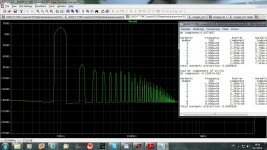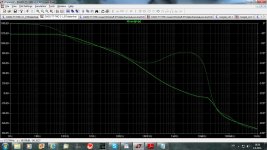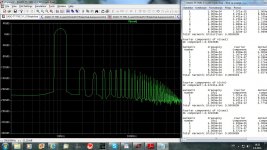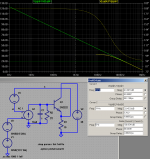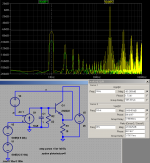Which I do, since it agrees well with what I hear. Therefore amplifier B would likely sound better to me, all else equal.UNLESS you subscribe to the distortion masking theory.
In fact H2 -90dB, H5 -105dB might be closer to an ideal roll-off. That far down, it will be hard to tell!
But it's a fine point not agreed on by many.
Which I do, since it agrees well with what I hear.
Me too, and I support you on this. Anyway, it is not so difficult to make own wav files with different kinds of distortion (Howard). I strongly support the fact that 0.1% THD purely 2nd harmonic is not the same as THD 0.1% constituted by sum of similar height distortion components.
Cheers,
Me too, and I support you on this. Anyway, it is not so difficult to make own wav files with different kinds of distortion (Howard). I strongly support the fact that 0.1% THD purely 2nd harmonic is not the same as THD 0.1% constituted by sum of similar height distortion components.
Cheers,
Absolutely, that's why THD is much more meaningful when H's decreases monotonically, 0.1% at equal H's could be horrid
No. The suppression of unwanted outputs at any frequency is determined by the loop gain at that frequency.
No. I'm not quite sure where to begin in unravelling your misconceptions, so I won't attempt it.
Both of these sentences are based on misconceptions about feedback..
Let s do an iterative reasoning..
To suppress the 1khz residual, the feedback loop will act on the 19/20khz
and thus, it s the available loop gain at these frequencies that allow for
suppression of unwanted by products that although being at lower
frequencies are produced by high frequencies that are intermodulating.
The available NFB at low frequencies is useless since the feedback loop
must be fast enough (understand high OLG at 19/20khz) to change the amplifier
transfer caracteristic as fast at least as the signals wich are processed , that is,
19/20khz.
In some way , you re putting the consequence , the 1KHZ signal, before
the cause , the 19/20khz signals wich are intermodulating.
Said in another way, the amp is unable to produce a 1khz signal as
a counterforce of the existing by product , it can only correct the
19/20khz as a mean to remove the unwanted low frequency by product,
and for this, it need higher OLG at high frequency...
Last edited:
Both of these sentences are based on misconceptions about feedback..
...
Said in another way, the amp is unable to produce a 1khz signal as
a counterforce of the existing by product , it can only correct the
19/20khz as a mean to remove the unwanted low frequency by product,
and for this, it need higher OLG at high frequency...
Agree ... and worse even if there is a 1KHZ input signal, it could be erroneously 'corrected' by NFB causing cross pollution ...
is your simulator broken? - try it
I see the lower IMD suppression effect of sloping loop gain in many of my sims - do I have to work up one just for this point?
Be careful with experiences protocols..
If you increase the low frequency OLG , likely that gain at high
frequencies has increased as well, but the compensation will make
it look negligible while in fact it s noticeable but the increased gain
at high frequency is simply used in the local compensation feedback
loop , thus increasing the linearity at high frequency while the global
NFB is the same...
Originally Posted by WuYit
It is troublesome for electrons to travel through capacitances
They dont have to , the displacement current takes there place.
I don't intend to repeat myself, as that is the way threads go round in circles. wahab is wrong, so is artu. I suggest they need to do some more reading. Feedback theory, Fourier theory would be good places to start. I assume they already understand basic electronics and maths, including trigonometry and power series (the basis of distortion mechanisms).
Let s do an iterative reasoning..
Lets do some more. The feedback reduces any signal at the output that is not present at the input, regardless of where it comes from. (put a 1khz signal gen with a reasonable source impedance on your amp output and watch). Do I need to continue?
for feedback theory this is Elementary
Why are we plagued with poseurs that make statements that only reveal they don't have a clue about what they’re commenting on?
Feedback Theory principles are readily explored in simulation, think of it as a numerical mathematical proof
1 KHz loop gain difference 30 dB, 1 KHz IMD from 19,20 KHz reduced by 29 dB re "flat gain" loop
Why are we plagued with poseurs that make statements that only reveal they don't have a clue about what they’re commenting on?
Feedback Theory principles are readily explored in simulation, think of it as a numerical mathematical proof
1 KHz loop gain difference 30 dB, 1 KHz IMD from 19,20 KHz reduced by 29 dB re "flat gain" loop
Attachments
Last edited:
I don't intend to repeat myself, as that is the way threads go round in circles. wahab is wrong, so is artu. I suggest they need to do some more reading. Feedback theory, Fourier theory would be good places to start. I assume they already understand basic electronics and maths, including trigonometry and power series (the basis of distortion mechanisms).
Basic theory state that to correct an error that is produced as a
result of two frequencies interacting , the feedback loop must be
fast enough to cope with the said signals, not with the resultants
of the interacting signals...
How a system that has improved linearity (higher OLG at LF) at 1ms
response time could correct signals wich have a 0.05ms period ??.....
You fail to understand that the amp must be able to correct
its output as fast as the slope of the input signals , that lead
you to boldly, but wrongly , brand whoever is not is the same
confusion as you as being wrong.
Why are we plagued with poseurs that make statements that only reveal they don't have a clue about what they’re commenting on?
Feedback Theory principles are readily explored in simulation, think of it as a numerical mathematical proof
1 KHz loop gain difference 30 dB, 1 KHz IMD from 19,20 KHz reduced by 29 dB re "flat gain" loop
So the loop gain is not increased at 20khz ?
How do you increase the loop gain at 1khz without seeing it increase
at 20khz as well ?.....
55db - 1k
100k... only 15db.
OS
15db at 100khz is very useful.
Your design must also be pretty linear I would think even out to 100k. Interesting to contrast it with the leach, which IIRC was about 0.2 at 20khz.
there is ~5.5 dB gain difference @20KHz - you are saying that explains the 30 dB change in 1 KHz IMD ?
the sim could tweak the GBW as well to get better than 1 dB match of 19,20 KHz
care to make a prediction about how much that would affect the results ?
the sim software is free
the sim could tweak the GBW as well to get better than 1 dB match of 19,20 KHz
care to make a prediction about how much that would affect the results ?
the sim software is free
Last edited:
Feedback doesn't know or care where the unwanted output components originated. It only sees the amp input and output and compares them. It doesn't know that the 1kHz came from intermodulation, so it doesn't know how to 'correct' the intermodulation. It does know how to reduce 1kHz, because that is something in the output which is not in the input. It does the same for ripple, noise, interference etc. It even does the same for the input signal, which is why the gain is reduced too.
Me too, and I support you on this. Anyway, it is not so difficult to make own wav files with different kinds of distortion (Howard). I strongly support the fact that 0.1% THD purely 2nd harmonic is not the same as THD 0.1% constituted by sum of similar height distortion components.
Cheers,
But Pavel, this is opinion and needs to be objectified through a DBT.
- Status
- This old topic is closed. If you want to reopen this topic, contact a moderator using the "Report Post" button.
- Home
- Amplifiers
- Solid State
- Feedback affects Soundstage, Imaging, Transients ?
